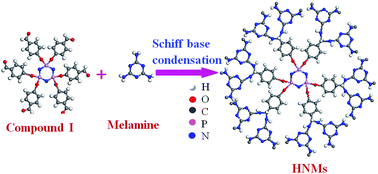Aminal linked inorganic–organic hybrid nanoporous materials (HNMs) for CO2 capture and H2 storage applications†
Abstract
Nitrogen-rich aminal linked inorganic–organic hybrid nanoporous materials (HNMs) with cyclophosphazene moieties in the frameworks were synthesized by a Schiff base condensation reaction. The ultra-microporous materials have a specific surface area (SBET) upto 976 m2 g−1 and could capture 18.9 wt% CO2 and 1.6 wt% H2 at 273 and 77 K, respectively, at 1 bar. The materials have a nitrogen content upto 42% which is the highest among the nanoporous materials category. The high nitrogen content is beneficial for several applications such as CO2 capture.

- This article is part of the themed collection: Editors Collection for RSC Advances - India

 Please wait while we load your content...
Please wait while we load your content...